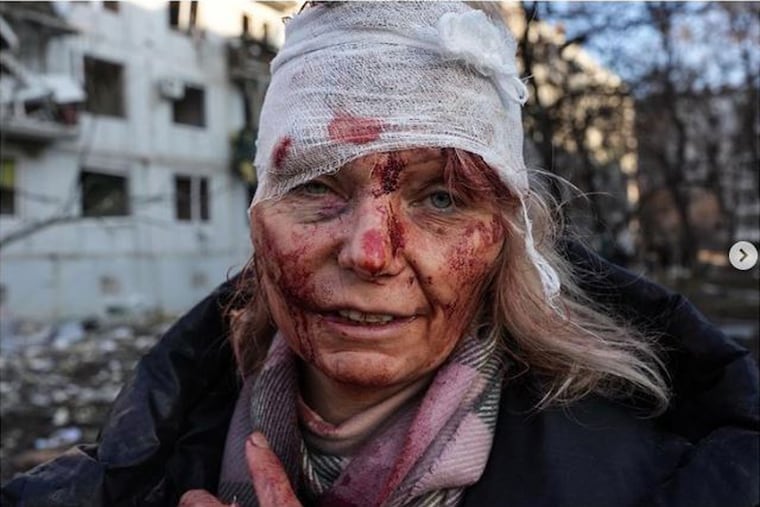Philly photojournalist in Ukraine documents early scenes of Russian invasion
For the 31-year-old Wolfgang Schwan, a Berks County native who lives with his younger brother in Philly’s River Wards section, it is his first time chronicling a war zone.

The photo of Helena’s bandaged face stared out at the world on Friday morning — one of the first victims of the Russian invasion that the world saw on the front pages of dozens of newspapers.
Blood checkered the woman’s face and leaked through the gauze bandages wrapped around her head. She was injured in a Russian airstrike that hit the eastern Ukraine city of Chuhuiv early on Feb. 24 just hours after Russian forces launched a full-scale invasion. And Philadelphia-based freelance photographer Wolfgang Schwan was one of the first journalists on the scene to document her survival.
“She was the first person that was walking up to us,” said Schwan, who arrived with other journalists in Chuhuiv within an hour of the blast. “She seemed concussed.”
He gathered her name, age and occupation — Helena, 53, teacher — and then moved on to continue shooting the wreckage. The missile had landed squarely between two Soviet-style apartment buildings, he said. First responders rushed in and out of the buildings, stepping over glass and debris to tend to the injured.
For the 31-year-old Schwan, a Berks County native who lives with his younger brother in Philly’s River Wards section, it is his first time chronicling a war zone. He is now one of many foreign journalists embedded in Ukraine to document the largest ground invasion in Europe since World War II.
Schwan arrived in the country in early January, and spent a month photographing servicemen in the eastern Donbas region alongside his fixer, Sergii Solodko. The specter of war felt real there. But back in the capital city of Kyiv, life remained its lively self — people dining in restaurants, going to night clubs, sightseeing in the streets — until the unthinkable happened on Thursday.
“You saw this giant Russian buildup in the news and that war was on the way, but if you didn’t read the news, you would have no idea any of that was happening,” Schwan said, in a phone interview Saturday from an Airbnb in downtown Kyiv.
“As of right now, Kyiv feels like a different planet,” he added.
Kyiv’s Mayor Vitali Klitschko ordered a curfew through the weekend amid reports that Russian “saboteurs” had infiltrated the capital. Schwan spent Friday at the metro station, taking pictures of residents who were either fleeing to the west for safety or, in fewer cases, heading east to the front lines to fight.
“It was absolutely packed with people, fighting to get on the trains,” he said.
At least 150,000 people fled Ukraine into neighboring Poland as the Russian assault on the country carried through the weekend, according to the United Nations relief agency. Skirmishes intensified around the city into Sunday, as city residents began stockpiling homemade Molotov cocktails.
“It’s a really quickly moving situation,” he said.
His entreé into photojournalism came only a few years ago. Schwan lives with his younger brother in the Fishtown-Kensington area, where he said the two co-run a small moving company.
After years of shooting pictures of rock climbing, his longtime hobby, Schwan pivoted into feature and spot news photography in 2020 — where there was “a low bar for entry,” he said. He said he simply showed up at major events and learned from other photojournalists.
Since then, he has covered the Jan. 6 siege on the U.S. Capitol, documented migrants seeking asylum across the U.S.-Mexico border, and photographed a Kurdish man who has cleared hundreds of thousands of land mines left behind by war.
In Philadelphia, Schwan has also taken photos of Kensington’s homeless encampments and reported on protests following the police killing of Walter Wallace Jr. All of this has felt “certainly more important than rock climbing,” he said.
He said he’ll remain in Ukraine unless it becomes clear that Russian forces have encircled the capital, in which case “we are ripping west,” he said.
Driving back to Kyiv after photographing Helena at the airstrike in eastern Ukraine, he and two other journalists were taken aback by the calmness of the countryside as war erupted in the distance. The sky was blue and clear. In another timeline, it might have felt like a road trip.
Schwan had to keep reminding himself: “Everything is different now.”